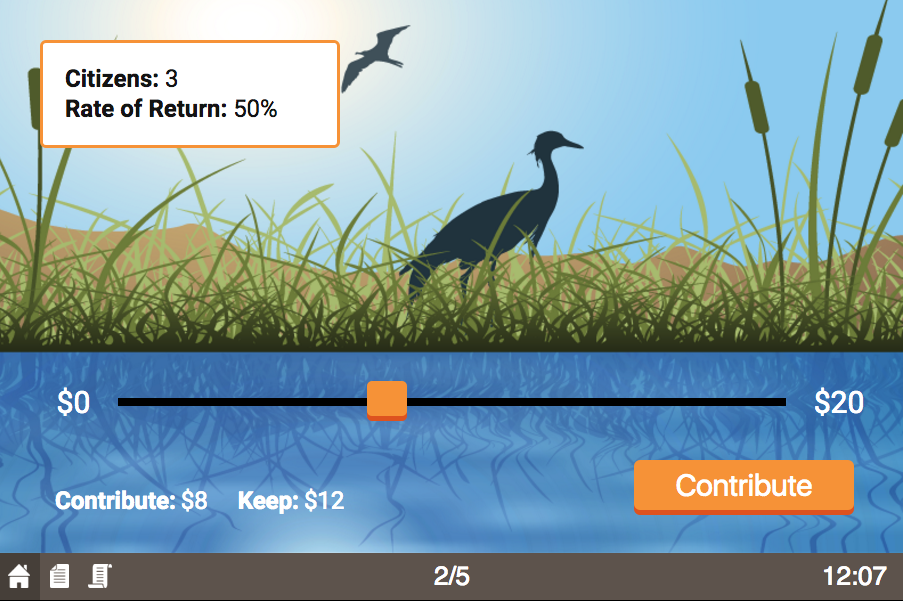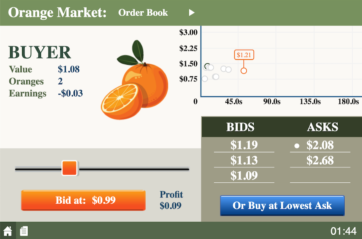On the road, a number of faculty asked a question similar to this, “Should I run MobLab games before or after I cover the material?” It depends. Let me illustrate with two examples. Example 1: The Linear Public Goods Game. Public goods provision is often talked about in the market failure chapter of a principles textbooks where the equilibrium free-riding prediction necessitates government intervention. In fact, over thirty years of experimental research on public goods provision has produced an empirical regularity that cooperation often starts at 40-60 percent of the maximum contribution and trends toward free-riding after several rounds of play.If you were to cover the free-riding prediction before student participation it would (likely) bias them towards less initial cooperation. This creates lost opportunities. First, students often express frustration in the public goods game because some of them attempt to cooperate while others choose to free ride. For learning this frustration is a good thing. It makes the game memorable. Second, it is possible that some groups are able to maintain high levels of cooperation (especially when communication is present). These cooperative groups can be a springboard into talking about how we form expectations, the importance of group identity, etc.
Example 1: The Linear Public Goods Game. Public goods provision is often talked about in the market failure chapter of a principles textbooks where the equilibrium free-riding prediction necessitates government intervention. In fact, over thirty years of experimental research on public goods provision has produced an empirical regularity that cooperation often starts at 40-60 percent of the maximum contribution and trends toward free-riding after several rounds of play.If you were to cover the free-riding prediction before student participation it would (likely) bias them towards less initial cooperation. This creates lost opportunities. First, students often express frustration in the public goods game because some of them attempt to cooperate while others choose to free ride. For learning this frustration is a good thing. It makes the game memorable. Second, it is possible that some groups are able to maintain high levels of cooperation (especially when communication is present). These cooperative groups can be a springboard into talking about how we form expectations, the importance of group identity, etc. Example 2: The Competitive Market Game. Supply and demand is the workhorse model of economics. In principles textbooks the market process is often described in terms of excess supply, excess demand, the invisible hand, and equilibrium. To the students, the whole invisible hand process can sometimes seem a little like superstition. In fact, this is how Tom Palfrey says he felt as an undergraduate at Michigan (see here).If you were to cover the supply and demand curves in advance and talk about related concepts, it is unclear whether it would alter behavior in a substantial way. In fact, students often view the theory as a lot of hand waving and not intuitive. In this case a game can provide clarity to the theory and curb skepticism by showing there is an empirical basis for the supply and demand model. What can be gleaned from these examples?
Example 2: The Competitive Market Game. Supply and demand is the workhorse model of economics. In principles textbooks the market process is often described in terms of excess supply, excess demand, the invisible hand, and equilibrium. To the students, the whole invisible hand process can sometimes seem a little like superstition. In fact, this is how Tom Palfrey says he felt as an undergraduate at Michigan (see here).If you were to cover the supply and demand curves in advance and talk about related concepts, it is unclear whether it would alter behavior in a substantial way. In fact, students often view the theory as a lot of hand waving and not intuitive. In this case a game can provide clarity to the theory and curb skepticism by showing there is an empirical basis for the supply and demand model. What can be gleaned from these examples?If you think knowledge of the theory will bias students toward a particular pattern of behavior, play the game first. Too many students take a description of equilibrium as a prescription for their behavior. Other examples of this might include the Commons Fishery, Beauty Contest, If you think the game will provide clarity to a theory that is not intuitive, play the game after a discussion of the theory. This will allow you to discuss the game in light of theory already learned. Other examples might include mixed strategies or how quantity restriction in a Cournot game earns more money.
 Example 1: The Linear Public Goods Game. Public goods provision is often talked about in the market failure chapter of a principles textbooks where the equilibrium free-riding prediction necessitates government intervention. In fact, over thirty years of experimental research on public goods provision has produced an empirical regularity that cooperation often starts at 40-60 percent of the maximum contribution and trends toward free-riding after several rounds of play.If you were to cover the free-riding prediction before student participation it would (likely) bias them towards less initial cooperation. This creates lost opportunities. First, students often express frustration in the public goods game because some of them attempt to cooperate while others choose to free ride. For learning this frustration is a good thing. It makes the game memorable. Second, it is possible that some groups are able to maintain high levels of cooperation (especially when communication is present). These cooperative groups can be a springboard into talking about how we form expectations, the importance of group identity, etc.
Example 1: The Linear Public Goods Game. Public goods provision is often talked about in the market failure chapter of a principles textbooks where the equilibrium free-riding prediction necessitates government intervention. In fact, over thirty years of experimental research on public goods provision has produced an empirical regularity that cooperation often starts at 40-60 percent of the maximum contribution and trends toward free-riding after several rounds of play.If you were to cover the free-riding prediction before student participation it would (likely) bias them towards less initial cooperation. This creates lost opportunities. First, students often express frustration in the public goods game because some of them attempt to cooperate while others choose to free ride. For learning this frustration is a good thing. It makes the game memorable. Second, it is possible that some groups are able to maintain high levels of cooperation (especially when communication is present). These cooperative groups can be a springboard into talking about how we form expectations, the importance of group identity, etc. Example 2: The Competitive Market Game. Supply and demand is the workhorse model of economics. In principles textbooks the market process is often described in terms of excess supply, excess demand, the invisible hand, and equilibrium. To the students, the whole invisible hand process can sometimes seem a little like superstition. In fact, this is how Tom Palfrey says he felt as an undergraduate at Michigan (see here).If you were to cover the supply and demand curves in advance and talk about related concepts, it is unclear whether it would alter behavior in a substantial way. In fact, students often view the theory as a lot of hand waving and not intuitive. In this case a game can provide clarity to the theory and curb skepticism by showing there is an empirical basis for the supply and demand model. What can be gleaned from these examples?
Example 2: The Competitive Market Game. Supply and demand is the workhorse model of economics. In principles textbooks the market process is often described in terms of excess supply, excess demand, the invisible hand, and equilibrium. To the students, the whole invisible hand process can sometimes seem a little like superstition. In fact, this is how Tom Palfrey says he felt as an undergraduate at Michigan (see here).If you were to cover the supply and demand curves in advance and talk about related concepts, it is unclear whether it would alter behavior in a substantial way. In fact, students often view the theory as a lot of hand waving and not intuitive. In this case a game can provide clarity to the theory and curb skepticism by showing there is an empirical basis for the supply and demand model. What can be gleaned from these examples?
